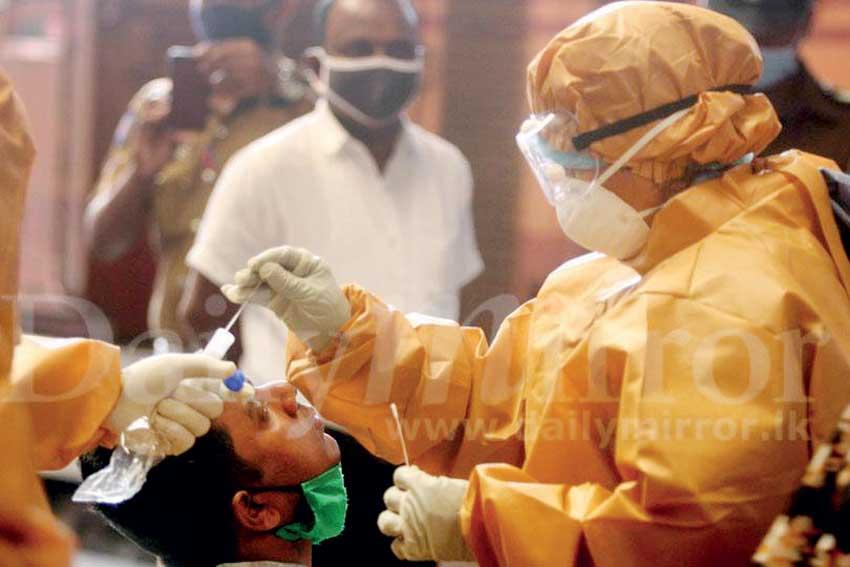Reply To:
Name - Reply Comment

All patients with respiratory symptoms should undergo PCR testing - Pic by Pradeep Dilrukshana
 The emergence of a new COVID-19 cluster has reminded the citizenry that the pandemic isn’t over yet. People have been asked to take extra precautions since the virulence levels in the virus were found to be high. While reminding the citizenry to take preventive measures, medics also suggest increased surveillance and monitoring as means of detecting cases quickly. Here’s what medics observe regarding the emergence of the new cluster.
The emergence of a new COVID-19 cluster has reminded the citizenry that the pandemic isn’t over yet. People have been asked to take extra precautions since the virulence levels in the virus were found to be high. While reminding the citizenry to take preventive measures, medics also suggest increased surveillance and monitoring as means of detecting cases quickly. Here’s what medics observe regarding the emergence of the new cluster.
Heavy viral load in new cohort
Medics have observed a heavy viral load in the new COVID-19 cluster emerging from the apparel manufacturing facility in Minuwangoda. “The rate of patients becoming positive is also low and many seem to be asymptomatic,” opined Dr. Jude Jayamaha, Consultant Virologist at Medical Research Institute. “Globally, the number of asymptomatic patients is high, but the risk is that they would spread the symptoms. This is a unique disease because we have to hunt and take samples. But the reproductive value is the same.” he added.
A lot of patients have low Cycle Threshold (Ct) values, which means that they have a high viral load and many of them are in the early part of the infection.
Increase surveillance and monitoring
Speaking at a webinar organised by the Sri Lanka Medical Association, Dr. Bodika Samarasekara, Consultant Respiratory Physician, District General Hospital, Gampaha said that all patients with respiratory symptoms should undergo PCR testing. “These patients need continuous monitoring thereby undergoing chest X-rays and basic investigations. On the other hand patients with other respiratory diseases such as chronic lung diseases and bronchitis are at risk of developing COVID-19 complications. Several patients with tuberculosis were diagnosed with symptoms similar to COVID. In 2020 alone, around 21 deaths have been reported due to TB. Therefore high risk patients need to be detected.” said Dr. Samarasekara.
Isolate and separate suspected patients
Sharing his thoughts, Ceylon College of Physicians President Prof. Ananda Wijewickrama said that having many asymptomatic cases is the usual nature of this virus. “But the number of cases is increasing and therefore we will have to lower the threshold of testing. It is important to increase surveillance at OPD and in-patient level and it is also important to do random sampling. Suspected patients should be isolated, separated and asked to take necessary precautions. A lot of patients have low Cycle Threshold (Ct) values, which means that they have a high viral load and many of them are in the early part of the infection. Therefore they may spread the infection easily.” said Dr.Wijewickrama.
He also pointed out that it is important to maintain ventilation in wards as means of minimising the risk of spreading the illness. “There’s a spike in dengue and leptospirosis patients and they could be identified by taking a full blood count and a C-reactive protein test (CRP). Apart from taking preventive measures it is also important to have a healthy diet and engage in regular exercises,” he added.
GH strain predominant in Sri Lanka
“Initial viral strains that we sequenced in March were similar to those in India and Europe,” opined Prof Neelika Malavige at the Department of Immunology and Molecular Medicine, Faculty of Medical Sciences at University of Sri Jayawardenapura. “The Kandakadu cluster was different to other virus sequences in Sri Lanka. Geographically there are seven strains out of which four (O,G, GH and GR) are found in Sri Lanka while the GH strain is the most predominant. If you look at the world trends, the O strain has decreased while GH and GR strains have increased. Mutational analysis is important to understand if the virus becomes more or less virulent with time. We have to know the virus strains in Sri Lanka and to know if a new strain is associated with increased transmissibility of response to antivirals. Of the things we sequenced there were a total of 153 mutations with 99 changes in amino acids. In Asian countries there are less mutations whereas in Western countries there are high mutation rates.
Prof. Malavige pointed out that there are 2 important mutations in the proteins in Sri Lankan strains. “One of them is the D614 to G614 mutation. When the SARS-CoV2 epidemic started we had the D614 mutation which was associated with a lower viral load, but later the G614 strain which took over the world had a higher viral load and higher transmissibility. In Sri Lanka 11/19 viruses that have been sequenced had the G614 strain associated with a high viral load.” said Prof. Malavige.
However she further said that irrespective of finding out which strain is dominating at the moment, it is important to take preventive measures to contain the virus.